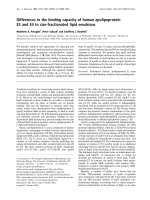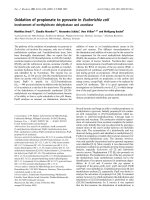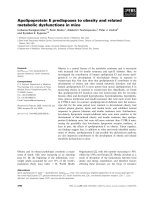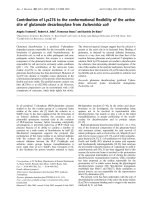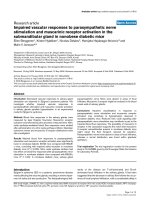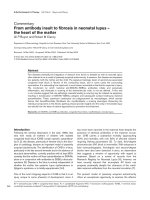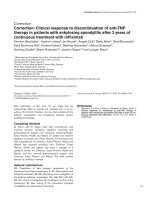Báo cáo y học: "Correspondence in relation to the case report "Capnography as an aid in localizing the phrenic nerve in brachial plexus surgery. Technical note." published in May issue of Journal of Brachial Plexus and Peripheral Nerve Injury" potx
Bạn đang xem bản rút gọn của tài liệu. Xem và tải ngay bản đầy đủ của tài liệu tại đây (170.52 KB, 2 trang )
BioMed Central
Page 1 of 2
(page number not for citation purposes)
Journal of Brachial Plexus and
Peripheral Nerve Injury
Open Access
Letter to the Editor
Correspondence in relation to the case report "Capnography as an
aid in localizing the phrenic nerve in brachial plexus surgery.
Technical note." published in May issue of Journal of Brachial Plexus
and Peripheral Nerve Injury
Pradipta Bhakta
Address: Dept. of Anaesthesiology and Intensive Care, Sultan Qaboos University Hospital, Muscat, Oman
Email: Pradipta Bhakta -
Abstract
Comment on 'Capnography as an aid in localizing the phrenic nerve in brachial plexus
surgery. Technical note' Bhagat H, Agarwal A, Sharma MS
Journal of Brachial Plexus and Peripheral Nerve Injury 2008, 3:14 (22 May 2008)
Dear Editors,
I want to thank the authors for this article explaining this
innovative technique to identify phrenic nerve intraoper-
atively. This may be applied a good technique as replace-
ment of currently available means. But after going
through the article I found some doubts related to the
actual correlation of diaphragmatic contraction with elec-
trical stimulation of phrenic nerve.
Authors have used an intravenous based anesthesia for
their cases without muscle relaxation. They have not men-
tioned anything about the dose of the drug used or mon-
itoring the depth or adequacy of anesthesia. Nor they
mentioned anything about intraoperative ventilatory
technique during maintenance of anesthesia. From the
pattern of the capnogram presented in the report, I can
assume that probably a controlled ventilatory technique
was used in all the cases [1]. Authors have assumed that
notches in the alveolar plateau part (phase III) of capno-
gram were because of diaphragmatic contraction elicited
by electrical stimulation. But there are several reasons of
appearance of notch in phase III of capnogram namely
curare cleft, hiccup, premature respiratory effort by the
patient during mechanical ventilation etc [1-3]. Though
curare cleft is out of question in these cases, but premature
respiratory effort provoked by painful electrical stimula-
tion in the scenario of inadequate anesthesia and analge-
sia should have been considered as a possibility [1-3]. It is
very well known that any electrical stimulation above 1–2
mA is very painful [4]. That is why it is advised to start
electrical stimulation with lowest possible current and to
increase it until stimulation is obtained. Though some or
most of these painful responses can be reduced or abol-
ished by use of anesthesia, painful stimulation like this
under inadequate anesthesia can manifest as hemody-
namic imbalance as well as premature respiratory effort.
Appearance of cleft in capnogram mentioned here is also
similar to that seen in case of premature inspiratory effort
[1]. This is specifically important when patient is kept on
ventilator with or without muscle relaxation or anesthesia
and analgesia are inadequate. There was no mention of
hemodynamic response to electrical stimulation. This
could have dictated us about rough guide of adequacy of
anesthesia in absence of any specialize depth of anesthe-
sia monitoring. That's why monitoring of anesthetic
Published: 22 October 2008
Journal of Brachial Plexus and Peripheral Nerve Injury 2008, 3:20 doi:10.1186/1749-7221-3-20
Received: 19 June 2008
Accepted: 22 October 2008
This article is available from: />© 2008 Bhakta; licensee BioMed Central Ltd.
This is an Open Access article distributed under the terms of the Creative Commons Attribution License ( />),
which permits unrestricted use, distribution, and reproduction in any medium, provided the original work is properly cited.
Publish with BioMed Central and every
scientist can read your work free of charge
"BioMed Central will be the most significant development for
disseminating the results of biomedical research in our lifetime."
Sir Paul Nurse, Cancer Research UK
Your research papers will be:
available free of charge to the entire biomedical community
peer reviewed and published immediately upon acceptance
cited in PubMed and archived on PubMed Central
yours — you keep the copyright
Submit your manuscript here:
/>BioMedcentral
Journal of Brachial Plexus and Peripheral Nerve Injury 2008, 3:20 />Page 2 of 2
(page number not for citation purposes)
depth and mentioning of drug dose are important. Noth-
ing was mentioned to rule out this possibility in the case
report. Even nothing was mentioned about occurrence of
hiccup, which is usually seen in case of phrenic nerve
stimulation [5]. This is a possibility in case of electrical
stimulation when muscle relaxant is not used.
They have also mentioned something about progressive
reduction in ETCO
2
level in subsequent capnogram trac-
ings. But they have not given any valid explanation to the
cause of this occurrence. Ventilator setting here is very
important. They have not mentioned anything about the
ventilator rate and tidal volume setting in their particular
case in relation to capnogram recording. Hypocarbia can
result from several causes. Most common of them is
hyperventilation (iatrogenic or induced by patient due to
inadequate anesthesia) [1]. Again premature respiratory
effort due to painful electrical stimulus can lead to hyper-
ventilation leading to reduction of end tidal CO
2
.
Thus I must admit here that this case report is a little bit
inadequate in ruling out other possibilities of diaphrag-
matic contractions rather than elicited by electrical stimu-
lation of phrenic nerve. Thus before accepting this
method as a new and innovative technique to detect
phrenic nerve in difficult surgical condition like this, this
common possibility should be ruled out. I hope to see
some valid explanation relating to my queries from the
authors.
Thanking you-
Sincerely yours,
Pradipta Bhakta
References
1. Moon RE, Camporesi EM: Respiratory monitoring. In Miller's
Anesthesia 6th edition. Edited by: Miller RD. Philadelphia: Elsevier
Churchill Livingstone; 2005:1455-462.
2. Dorsch JA, Dorsch SE, editors: Understanding anesthesia equipment 3rd
edition. Baltimore: Williams & Wilkins; 1994:581-596.
3. Hensler T, Dhamee MS: Anesthesia machine malfunction simu-
lating spontaneous respiratory effort. J Clin Monit 1990,
6:128-131.
4. Hadzic A, Vloka JD, Claudio RE, et al.: Electrical nerve localiza-
tion: effects of cutaneous electrode placement and duration
of stimulus on motor response. Anesthesiology 2004,
100:1526-1530.
5. Raj PP, Andres JD, Grossi P, et al.: Aids to localization of periph-
eral nerves. In Textbook of regional anesthesia Edited by: Raj PP. New
York: Churchill Livingstone; 2003:309.
